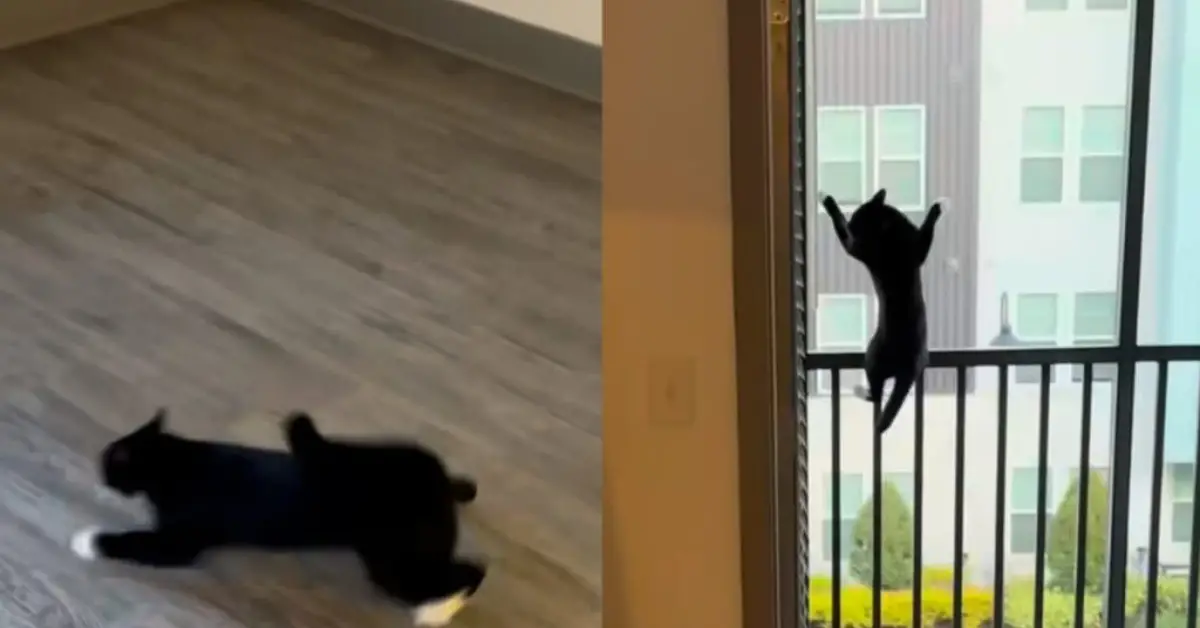The lines between urban life and nature have blurred in unexpected ways. It’s not uncommon for outdoor enthusiasts to worry about encountering wild animals in their natural habitat. After all, we’ve all heard stories of people discovering wild animals in remote areas. But what if the wild animals start venturing into our backyards?
The Surprising Encounter
A recent viral video posted to TikTok left viewers in shock and awe, as a house cat came face-to-face with a couple of bobcats in the pet owner’s backyard. The clip was shared by user SoulBoundSaga (@soulboundsaga), who was filming his cat as it stared out the window, seemingly watching birds. To his surprise, the cat wasn’t just observing birds—it was staring right at two bobcats, who had wandered into the yard.
As the video plays, you can hear the owner’s voice in the background, exclaiming, “Oh, that’s different!” His calm but surprised reaction perfectly captures the bewilderment that many of us would feel in a similar situation.
Why Are Wild Animal Encounters Important?
While some might view these encounters as shocking, they are an indication of a larger trend: wild animals moving further into human-inhabited areas. This is becoming an increasingly common problem as urban sprawl continues to expand, posing a serious threat to both humans and wildlife.
For example, pet owners in Los Angeles County frequently report coyote attacks, and in other places, bears have been spotted rummaging through garbage cans near residential areas. These types of interactions highlight the ever-increasing overlap between human habitats and the natural world.
But Why Is This Happening? And Why Is It Becoming More of A Problem?
The root cause lies in human population growth and urban expansion. As more neighbourhoods are built, natural habitats for animals are destroyed, and the animals are left to search for new areas to live. But that’s not all. Climate change has further exacerbated this issue by making traditional sources of food and water more scarce for wildlife. In turn, animals are forced to venture further into human territories in search of sustenance.
The Growing Concern for Pets
This trend of wild animals coming into closer contact with human settlements is particularly concerning for pet owners. Cats and dogs are at risk, and unfortunately, the danger can be deadly. Coyotes, bobcats, and even larger predators, such as bears, can pose a serious threat to domestic pets, especially when left outdoors unsupervised.
There have been numerous reports of pets being attacked and killed by wild animals in suburban and even urban settings. In many cases, these incidents end tragically with the wild animal being euthanised out of concern for public safety.
This situation highlights a larger issue that many cities and towns are struggling to address—how to balance the needs of growing human populations with the preservation of natural habitats for wildlife.
The Environmental Impact of Urbanisation
Wildlife encounters in urban and suburban areas are not just dangerous for people and pets—they also have serious environmental consequences. Our ecosystems rely on the diversity of animal and plant life to thrive. When wild animals are forced to leave their natural habitats, it disrupts the delicate balance of the ecosystem.

Every animal plays an important role in maintaining the health of the environment, whether it’s pollinating plants, controlling pests, or dispersing seeds. When these animals are pushed out of their homes or killed in conflicts with humans, the impact can be devastating.
Additionally, the loss of biodiversity affects our food sources. Many of the crops that feed us rely on pollination by wild insects, and the loss of animals that help maintain healthy ecosystems can reduce the availability of these essential resources.
What’s Being Done to Solve the Problem?
While the issue of wild animals venturing into human spaces is a pressing concern, efforts are being made to mitigate it and promote coexistence between humans and wildlife.
One promising solution is the idea of building “wildlife-friendly cities.” According to Christopher Schell, an ecologist and assistant professor at the University of California, Berkeley’s Rausser College of Natural Resources, the success of wildlife in urban areas will depend on our ability to build cities that are not only human-friendly but also wildlife-friendly. This includes integrating green spaces, wildlife corridors, and other conservation measures into urban planning.
The idea is to create spaces where wildlife can move safely without coming into conflict with humans. In cities like San Francisco, there have been efforts to expand green spaces and protect natural habitats, which in turn provide safe havens for animals.
Beyond urban planning, there are also conservation projects that are working to address the issue at its roots. Large land donations made by individuals and organisations have created protected areas where wildlife can live without being disturbed by human activities. These conservation areas are especially critical as the natural habitats of many species continue to shrink.
Moreover, there are efforts to repopulate endangered species through scientific innovations. Some researchers are even exploring the possibility of cloning endangered animals to help repopulate dwindling populations. On a more localised level, scientists are studying the genetics of trees and plants to ensure their survival in the face of changing environmental conditions.
Preserving Our Environment and Ensuring Future Biodiversity
As human populations grow and climate change continues to reshape the planet, it’s becoming increasingly clear that we need to protect the natural world if we want to ensure our future. The idea of “biodiversity” is no longer a far-off concept—it’s something that directly impacts our everyday lives. From the food we eat to the air we breathe, the health of our ecosystems is vital to our survival.
Ultimately, the challenge lies in striking a balance. We must continue to build and expand our cities, but we must also find ways to protect wildlife and preserve natural habitats. Through improved urban planning, conservation efforts, and scientific advancements, it is possible to create a future where both humans and wildlife can coexist and thrive together.
Conclusion
The viral video of the cat and bobcats serves as a wake-up call. It’s not just an amusing or shocking moment—it’s a reminder that wild animals are increasingly encroaching on our spaces, and we need to rethink how we coexist with them. The question now is: how can we ensure that wildlife remains protected while also allowing humans to live and grow in their ever-expanding urban environments?
Disclaimer: This article has been meticulously fact-checked by our team to ensure accuracy and uphold transparency. We strive to deliver trustworthy and dependable content to our readers.




